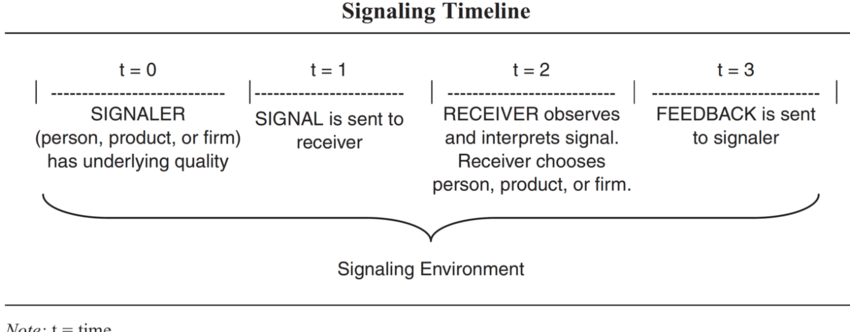3 Organizations
3.1 Signaling Theory
See (Connelly et al. 2010; Kirmani and Rao 2000) for review in management and marketing
When do we diverge? When choices signal identity (observability, functional benefits, etc.)
People diverge to signal identity, which based on:
- Observability
- Functional benefits
“The more costly something is, the more likely it is to retain its value as a clear and accurate signal.” (Berger 2016) Costs in this case could be:
- Monetary
- Opportunity
- Time
Price and branding (brand prominence) has an inverted-U relationship The higher the price is, the more brand prominence it possess. However, for the ultra rich class, the highest price does not command highest brand prominence, but actually lowest brand prominence. (a small set of ultra rich people know)
“The identity-signaling drives things to both catch on and die out… Counterfeiting helps speed up the process”
Counterfeit and piracy are good because it keeps consumers crave for a new one (Berger 2016)
We know that the mere exposure can increase our preference towards an object. Interestingly, the similarity between a new object and one that we are familiarity with also have the same effect. Novel but don’t be too novel.
-
2 parties:
Sender: chooses whether and how to communicate (signal) information
Receiver: chooses how to interpret the signal
Signaling theory is about reducing information asymmetry between two parties. (Spence 2002)
-
(Stiglitz 2000) find two types of information where asymmetry is important:
Info about quality: where quality is defined as “the underlying, unobservable ability of the signaler to fulfill the needs or demands of an outsider observing the signal” (p. 43). This is different from reputation or prestige (because the latter two are socially constructed as the consequence of the signaler’s unobserved quality.
info about intent

Figure 2 (p. 44)
Signaler: insiders who possess full information about something that receiver want to obtain information
-
Signal: typically insiders reveal positive information to close the information asymmetry gap (not negative one). Two characteristics of efficacious signals
Signal observability: “the extent to which outsiders are able to notice the signal” (p. 45)
Signal cost:
Receiver: outsiders who lack info about the organization
See Table2 for key constructs for this theory.
(Kirmani and Rao 2000) Review of signaling in marketing
3.2 Resource Dependence Theory
External resources (or the procurement of external resources) of organizations can influence the organization’s behavior (Stern, Pfeffer, and Salancik 1979)
The basic premise is as follows:
Organizations depend on resources, which depends on its environment, where other organizations play a big part to operate (ecology). And resources are power, and one organizations need others to survive. Hence, power and resource dependence are interlocked.
Since an organization’s power (A) over another (B) is the same thing as organization B’s dependence on organization A. We can see that power is relational and situaitonal.
3.3 Resource based Theory
Also known as resource-based view (RBV)
Background reading
(Wernerfelt 1984) was the first seminal paper on RBV. Later on, (J. B. Barney, Ketchen, and Wright 2011) argued for RBV to be considered a theory.
Related to the market-based assets framework (Srivastava, Shervani, and Fahey 1998)
3.3.1 Assumptions
- Resource heterogeneity assumption
Firms have different bundles of resources (Peteraf and Barney 2003). Hence, firms are skilled at certain activities due to their unique resources.
- Resource immobility assumption
Differences in resources can be sustained due to the difficulty in trading resources.
Based on these two assumption, RBT argues that since other firms find these valuable resources too costly or too difficult to imitate, then firms having these resources can have sustainable competitive advantage (SCA) (J. B. Barney and Hesterly 2012)
Since not all resources are drivers of SCA, only resources are “simultaneously valuable, rare, imperfectly imitable, and exploitable by the firm’s organization”. (based on VIRO) (Kozlenkova, Samaha, and Palmatier 2013)
3.3.2 VIRO
Resources refer to “tangible and intangible assets firms use to conceive of and implement its strategies.” (J. Barney and A. Arikan 2001) which consists of:
- physical
- financial
- human
- organizational
Another categorization of resources includes capabilities, and dynamic capabilities
In marketing strategy, resources that are usually studied are:
- brand
- relational
- knowledge
Marketing uses the RBT to provide rationale to invest in marketing activities that lead to long-term performance.
Market-based resources refer to “a subset of firm resources (assets and capabilities) related to marketing activities, such as building brands, relationships, innovations, or knowledge.” (Kozlenkova, Samaha, and Palmatier 2013).
- “Resource intangibility Most resources studied in marketing are intangible (e.g., brand and relational assets, knowledge generating capabilities).”
- “Complementarity means that the benefits from one resource are leveraged by the presence of another.” (Morgan, Slotegraaf, and Vorhies 2009).
When doing research and arguing for a resource as VIRO, one should refer to table 3 of (Kozlenkova, Samaha, and Palmatier 2013)
RBT can apply not only to firm-level of analysis, but also exchange-level of analysis.
3.3.2.1 Valuable
Firm resources are valuable if they “enable a firm to develop and implement strategies that have the effect of lowering a firm’s net costs and/or increase a firm’s net revenues beyond what would have been the case” without these resources (J. B. Barney and Arikan 2017)
3.3.2.3 Imperfectly Imitable
Hard to obtain or develop
If the organization possesses resources that are VIR (Valuation, rare, and imperfectly imitable), it has sustainable competitive advantage
3.3.2.4 Organization
firms must be “organized to exploit the full competitive potential of its resources and capabilities” (J. B. Barney and Hesterly 2012, 94)
3.4 Resource advantage theory
Competitive advantage (Hunt 2007):
- an efficiency advantage
- an effectiveness advantage
- an efficiency-effectiveness advantage